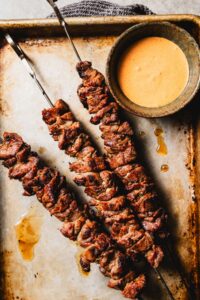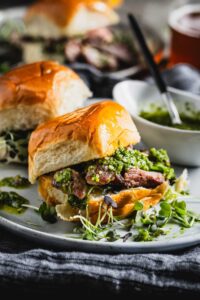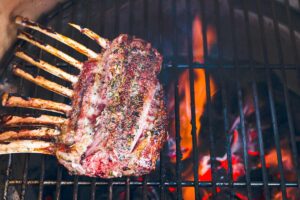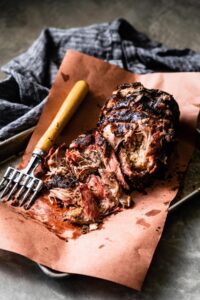Welcome to the ultimate grilled lamb guide! Lamb and your grill were meant for each other. If you’ve ever felt hesitant about grilling lamb, fear no more. In this guide, we’ll walk you through some simple tips and techniques that will boost your confidence at the grill all summer long.
Different cuts of lamb will use slightly different techniques. For example, thick-cut lamb loin chops or a grilled leg of lamb will use a two-zone grill setup, and lamb kabobs will be quickly grilled over direct. And then there’s low-and-slow smoking, which you would use for a smoked lamb shoulder. Get ready to create mouthwatering dishes with beautiful color and delicious flavors.
Sourcing Lamb
Sourcing high-quality lamb is the first step to success. I am a big fan of buying American lamb that is as local as possible to your location. Your local butcher is often the best place to start because they will know where the animals came from, but many grocery stores are now carrying great products and there are a number of online sources that can deliver right to your doorstep as well. Find out where to buy American lamb.

Prepping and Seasoning Lamb for the Grill
Before you fire up the grill, it’s important to properly prep and season your lamb for optimal flavor and texture.
Trim excess fat: Start by trimming off excess fat to avoid flare-ups on the grill, and it can also help it cook more evenly. Scoring any fat caps in a cross-hatch pattern will help the fat render more easily.
Season Early: Plan ahead and season the lamb at least an hour before cooking, or preferably the day before. This acts as a dry brine and gives the salt enough of time to penetrate all the way through the meat, bringing out all that wonderful flavor and to help keep the lamb juicy.
Wondering how much salt to use? As a general guideline, aim for about 1 teaspoon of Diamond Crystal Kosher Salt (or 3/4 teaspoon of Morton Kosher Salt) per pound of lamb, evenly coating all sides. Read our Salt 101 guide to learn more about salt.
Marinating: Lamb takes marinades really well. The goal is to just enhance the natural flavor of the lamb, and not overpower it. If you have high-quality lamb, simply season to complement its taste.
When marinating lamb (like for Kabobs), marinate for at least 6 to 8 hours to allow the marinade to fully work its magic. If you are on a time crunch, even an hour with a strong marinade will add some flavor.
Temper the meat: Taking the lamb out of the refrigerator and letting it sit out at at room temperature for at least an hour will help it cook through much more evenly. While it’s not always necessary, it is one of the variables that change overall cooking times.

Setting up the Grill
Properly setting up your grill is the key to grilling success. Whether you have a charcoal, pellet, or gas grill, the setup principles remain the same. First, ensure that your grill has a lid, which helps regulate temperature and reduce flare-ups.
Always pre-heat the grill before cooking. This allows the grates to get plenty hot for a proper sear and helps prevent food from sticking.
Clean the grill grates with your favorite grill brush or use tongs and a crumpled ball of aluminum foil to scrape the grates. Then dip a folded paper towel in canola oil and using tongs, wipe the grill grates to clean them and add a thin layer of oil to help prevent sticking.
If it’s been a while since you have used that grill, check out the grilling season checklist.
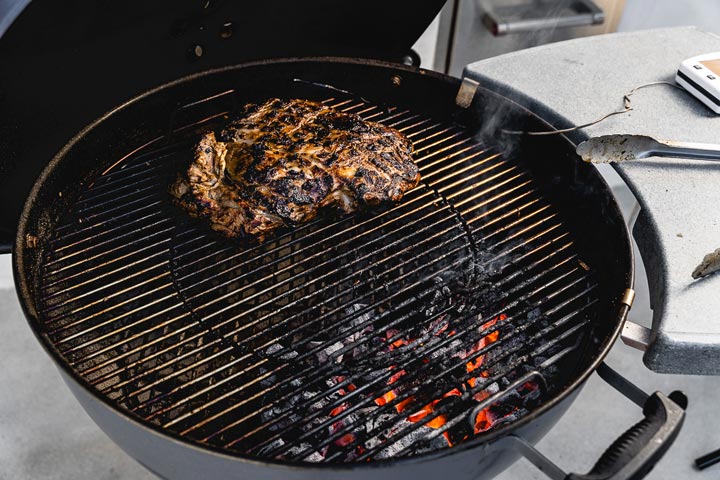
The two-zone setup: One popular setup technique is the two-zone cooking method.
This setup involves creating a hot side and a cool side on the grill. It’s ideal for cooking different cuts of lamb and achieving precise doneness. Direct heat is applied on the hot side, while indirect heat is used on the cool side. Indirect heat is perfect for slow cooking or when you want to avoid charring the lamb.
Lid open or closed? You will generally want to grill with the lid closed for more heat control and to promote even cooking as well as prevent flare-ups.
Adjust the grill’s vents: Don’t be afraid to adjust those vents to control the temperature. The more open the vents are, the more airflow and the hotter it will get inside the grill. The more closed, the less airflow and the cooler it will stay.
Soak those skewers: If you are using wooden skewers, always soak them in water for at least 30 minutes so they don’t burn on the grill. Consider buying metal skewers that are reusable and also flat, which makes turning skewered foods much easier.
Choose the right wood for smoke: When smoking lamb, pairing it with the right wood makes a big difference in the flavor. Apple, cherry and oak are my favorites for smoked lamb.

Grilling Different Cuts of Lamb
Below are the recommended grilling methods for different cuts of lamb
- Lamb Loin Chops: Best grilled, using high, direct heat for a short period of time to sear (on all sides) to develop a flavorful crust. Optimally cooked to medium-rare. If they are thick chops, it’s best to move them to the indirect heat side of the grill to finish cooking to an even doneness.
- Leg of Lamb: Best cooked using indirect heat because of the large size. Sear all sides over high heat then move to the indirect side to cook to the desired doneness. The reverse-sear method or smoking then searing is also great for grilling leg of lamb.
- Lamb Shoulder: Ideal for slow-cooking methods such as smoking. Cook over indirect heat using low-and-slow temperatures for a tender and succulent result.
- Lamb Kabobs: Grill over direct heat, rotating every 2 to 3 minutes to cook evenly. Cook until the internal temperature reaches the desired doneness (medium temp recommended).
- Ground Lamb Patties for Lamb Burgers and Lamb Kofta (Lamb Kebabs): Grill over medium-high heat using direct heat.
- Rack of Lamb: Sear on the grill over direct high heat for 3 to 5 minutes per side with the lid open, move to the indirect heat side to finish cooking with the lid closed. Grill using indirect heat for even cooking, then sear over direct heat for a crispy exterior. Medium-rare is optimal for rack of lamb.
Tips for Grilling
The ultimate goal when grilling lamb is to achieve a flavorful crust on the outside while keeping the inside juicy and tender with the doneness we are going for.
- The sear is crucial for creating that sought-after ultra-flavorful crust. It adds depth and enhances the overall taste of the lamb. Just be careful not go too far, as the fat on the lamb can char.
- Reverse sear: Another grilling technique is to use the reverse sear. Instead of first searing the lamb on the hot side, then moving it to the cooler side to finish, you do the opposite. First, cook it most of the way through on the cooler side of the grill, then remove it and crank up the heat before quickly searing on all sides.
This has some big advantages including even cooking that makes it easier to get the desired doneness, a better sear because the meat is dried and less of a need to rest. You can also add smoke flavor during the initial cook, which is delicious. - Sous vide: Similar to reverse sear, a modern technique is to first sous vide the meat vacuum sealed in a temperature-controlled water bath to a precise doneness, then quickly sear it on the grill (or smoke to add flavor) to finish. This method works wonderfully for large cuts like lamb leg or shoulder.
- Lamb Cooks Quickly: Keep in mind that lamb cooks quickly and can get tough and dry when overcooked.

How to Know When the Lamb is ‘Cooked’
When it comes to cooking lamb, cooking to a specific temperature rather than time is crucial for achieving the desired level of doneness. Cook the lamb to the appropriate internal temperature rather than relying solely on cooking time. The variables that affect cooking time include the thickness of the meat and its starting temperature, the grill’s temperature, and the desired level of doneness, etc. Here’s how you can ensure your lamb is cooked to perfection:
Use Thermometers: Invest in a high-quality instant-read meat thermometer to accurately gauge the internal temperature of the lamb. A remote probe thermometer is invaluable for remotely monitoring the temperature of both your meat and the grill.
Insert the thermometer into the thickest part of the meat, avoiding bone or fat. Don’t rely on your grill’s built-in thermometer, as they are often not accurate.
Different cuts of lamb have varying ideal cooking temperatures:
Lamb Doneness Chart
Tip: Remove the lamb from the heat about 5° F prior to the target finished temperature, as the temp will continue to rise.
Consider Carry-Over Cooking: The meat’s internal temperature will continue to rise slightly even after removing it from the grill. The larger the cut and the higher the temperature it was cooked at, the more the temperature will rise. This is known as carryover cooking.
To account for this, you can remove the lamb from the heat when it’s 5 to 10 degrees below your desired temperature. Allow it to rest for a few minutes before serving. During the resting period, the temperature will equalize, resulting in perfectly cooked lamb.
By using temperature as a guide and considering the variables at play, you can confidently cook your lamb to the desired level of doneness.
The Rest
When the lamb is taken off the grill, transfer it to a cutting board to rest. This resting period allows the residual heat to continue cooking the lamb gently while the juices redistribute. Depending on the size of the cut, a good rule of thumb is to let it rest for about 5 to 10 minutes. For larger cuts or whole roasts, you may want to extend the resting time to 15 to 20 minutes.
Cutting into the meat without resting will let those flavorful juices will spill out and cause it to dry out.
Slicing and Serving
Now that your perfectly cooked lamb has been rested, it’s time to present it in a way that truly highlights its flavors and makes it an inviting dish for everyone to enjoy. Here are some tips for serving your lamb:
- Carving and slicing: Depending on the cut of lamb, carving and slicing may be necessary before serving. Always slice against the grain for optimal tenderness. A long and sharp slicing knife is perfect for making clean cuts through a roast.
- Plating presentation: Lamb is often a stunning center piece for a holiday meal. Put it on a serving platter that makes it shine, or use a large cutting board. Garnish with some fresh herbs like thyme, rosemary, mint, basil or whatever you have in the garden.
- Accompaniments: Pair your lamb with delicious sides and condiments that complement its taste. Roasted vegetables, a fresh salad, couscous, mashed potatoes, polenta, or a bright mint chimichurri are wonderful.
- A finishing touch: Most grilled lamb can benefit from a sprinkle of finishing salt, a drizzle of olive oil and a squeeze of lemon.
Useful Tools & Accessories
To make your lamb grilling experience even more enjoyable and efficient, having the right grill and smoker tools and accessories can make a huge difference. Here are some essentials that I highly recommend:
- Grill Tongs: A sturdy pair of long-handled tongs is a must-have tool for handling and flipping the lamb on the grill. Look for tongs with a secure grip and heat-resistant handles for added safety.
- Meat Thermometer: An instant-read meat thermometer is an invaluable tool for achieving the perfect level of doneness. Ensure that your lamb is cooked to the desired temperature by checking its internal temperature accurately.
- Remote Meat Thermometer – Being able to remotely monitor your grill’s temp and the internal temp of the meat without opening the lid is a game changer.
- Charcoal Chimney Starter: If you’re using a charcoal grill, a chimney starter is an excellent accessory to have. It allows you to efficiently and evenly light the charcoal, ensuring a consistent heat source for grilling your lamb.
- Skewers: For grilling lamb kabobs or smaller cuts, metal skewers that are flat are much easier to turn than round skewers. They are also reusable.
- Basting Brush: A silicone basting brush is useful for applying marinades, sauces, or glazes to the lamb while it cooks. Silicone is heat resistant and easy to clean in the dishwasher.
- Grill Gloves: Heat-resistant grill gloves provide protection when handling hot grilling equipment, such as grill grates or chimney starters. They offer flexibility and allow for better control when working with the grill.
- Sheet pans: There are countless uses for sheet pans. From marinating to bringing meat out to the grill to even serving it.
Summary
Mastering the art of grilling lamb allows you to create flavorful and tender dishes opening up your world to new and delicious flavors. By following proper techniques, seasoning, and utilizing the right tools, you can achieve delicious results every time. Embrace the process and enjoy the wonderful flavors that grilled lamb brings to your table.
Happy grilling!



